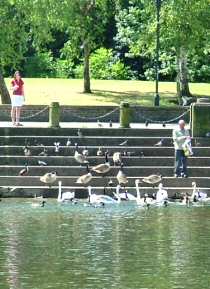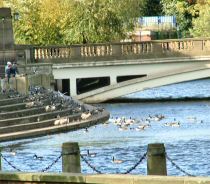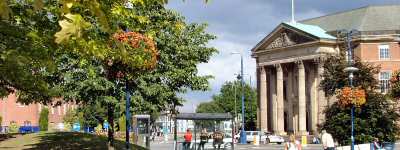|
Riverside Gardens
-
The gardens are located in the
centre of the city centre, along
the west bank of the River Derwent, behind the Council House. They look up towards Exeter
Bridge on Derwent Street and extend down towards Bass Recreation Ground.
They
provide a quiet place for both visitors and workers to get away from
modern day stresses and strains. To sit and watch
the
swans and ducks on the river and see the water cascading over the weir.
The
gardens have changed considerably from the original design, which
included a large formal pond planted with lilies and also adorned with
two large bronze turtle sculptures.
The
turtles have been moved to the ornamental pond in the grounds of Allestree Hall in Allestree Park.
An image of one of the turtles may be found on this website by visiting
the Allestree Park feature.
.
 |

History -
The
Riverside Gardens were created before the building of the Council House
and were officially opened
in 1934.
They provide a peaceful spot away from the hustle and bustle of the city
centre.
The
weir, missed by so many visitors to the city who tend to migrate towards
the busy shopping centre, is a particularly attractive feature of the
river scene. A little further along the river under
the
Holmes Bridge, the green space extends into the Bass Recreation
Ground.
His statue
stands in front of the Library and Museum, in the Wardwick which he
helped to finance.
Michael
Thomas Bass, MP for Derby from 1847 to 1883 was a generous local
benefactor. The grandson of the founder of the brewery that bore his
name, he gave the land to the town on which the Bass Recreation Ground
now stands.
The
outbreak of Second World War delayed the completion and hand over of the
Council House . It was requisitioned by the RAF in 1942 and not
handed back to the Council for another four years. It was finally
officially opened by Princess Elizabeth and her husband, Price Philip in
1949. It is a home to the city’s collection of treasures, which are kept
in the Mayor’s Parlour. |
Park Facilities
-
the
River Derwent, attracts wildlife
-
fishing downstream of the weir
-
Exeter
Bridge featuring ‘Bas relief’ sculptures of four famous Derbeians
-
gardens landscaped with lawns, flowerbeds and rockeries
-
seating areas to relax
-
open
space for walking
-
the
gardens form part of Riverlife Way
Riverlife Way
The path/cycle
track extends down from the north side of the city at Darley Park to the
Riverside Gardens. It continues through
Bass Recreation Ground,
past Pride Park and onto Alvaston Park. Eventually arriving at Elvaston
Country Park.
Exeter Bridge
Exeter
Bridge is a fine stone bridge built in the mid 1800s, to replace
an earlier wooden one. It takes its name from the Earl of Exeter whose
house stood nearby. The bridge was widened during reconstruction before
the Second World War. At the four corners of the bridge, bronze relief
panels remind us of notable figures from past generations.
The
figures are
William Hutton, the historian, the
philosopher Herbert Spencer and
Joseph
Wright, the painter who was born at 28 Iron Gate. Although Erasmus Darwin was not a Derby man, he lived in the
town and its immediate surrounds from 1781 until his death in 1802.
One of
his homes was in Full Street.
|

